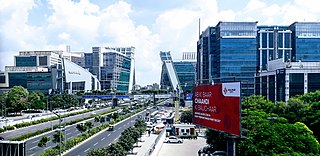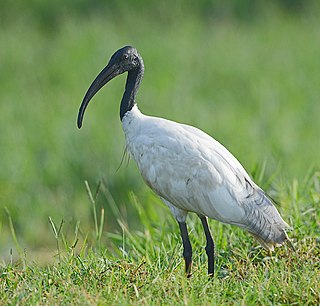Related Research Articles

Haryana is a state in India located in the northern part of the country. It was carved out of the former state of East Punjab on 1 November 1966 on a linguistic basis. It is ranked 22nd in terms of area, with less than 1.4% of India's land area. Chandigarh is the state capital, Faridabad in National Capital Region is the most populous city of the state, and Gurugram is a leading financial hub of the NCR, with major Fortune 500 companies located in it. Haryana has 6 administrative divisions, 22 districts, 72 sub-divisions, 93 revenue tehsils, 50 sub-tehsils, 140 community development blocks, 154 cities and towns, 6,848 villages, and 6222 villages panchayats.

Gurugram, formerly known as Gurgaon, is a city located in the northern Indian state of Haryana. It is situated near the Delhi-Haryana border, about 30 kilometres (19 mi) southwest of the national capital New Delhi and 268 km (167 mi) south of Chandigarh, the state capital. It is one of the major satellite cities of Delhi and is part of the National Capital Region of India. As of 2011, Gurgaon had a population of 1,153,000.

Najafgarh is a city in the South West Delhi district in the National Capital Territory of Delhi, India. It is one of the three subdivisions of the Southwest Delhi district. Najafgarh is located at the outskirts of the southwestern part of Delhi near the Haryana border, a distance of 29 kilometres from the New Delhi City Center. It has a mixture of rural and urban populations from Delhi and Haryana.

Haryana, formed on 1 November 1966, is a state in North India. It is divided into 6 revenue divisions, 5 Police Ranges and 3 Police Commissionerates.

The Najafgarh drain or Najafgarh nalah, which also acts as Najafgarh drain bird sanctuary, is another name for the northernmost end of River Sahibi, which continues its flow through Delhi, where it is channelized, and then flows into the Yamuna. Within Delhi, due to its channelization for flood control purposes, it is now erroneously called "Najafgarh drain" or "Najafgarh nullah." It gets this name from the once famous and huge Najafgarh Jheel (lake) near the town of Najafgarh in southwest Delhi and within urbanized Delhi. It is the Indian capital’s most polluted water body due to direct inflow of untreated sewage from surrounding populated areas. A January 2005 report by the Central Pollution Control Board classifies this drain, with 13 other highly polluted wetlands, under category ‘‘D’’ for assessing the water quality of wetlands in wildlife habitats.
Najafgarh Lake, Najafgarh Marsh or Najafgarh Jheel, fed by Sahibi River, used to be a vast lake in the south west of Delhi in India near the town of Najafgarh from which it takes its name. It was connected to the river Yamuna by a natural shallow nullah or drain called the Najafgarh nullah. However, after the 1960s the Flood Control Department of Delhi kept widening the Najafgarh drain in the pretext of saving Delhi from floods and eventually quickly drained the once huge and ecologically rich Najafgarh lake completely. Rainwater accumulating in the Najafgarh lake or jheel basin had been recorded to have occupied more than 300 square kilometres (120 sq mi) in many years before its unfortunate draining.

Najafgarh drain bird sanctuary(proposed)and wetland ecosystem is composed of the wetland ecosystem and wildlife habitat on several kilometres of the Najafgarh drain or nullah which passes through rural southwest Delhi in India's capital territory. It includes the portion draining the depression or basin area that formed the once famous but now completely drained Najafgarh lake or Najafgarh jheel.
Chhawla or Najafgarh drain city forest consists of forestry plantations near the town of Chhawla on both embankments of Najafgarh drain, which is the delhi-end of Sahibi River originating from Aravalli range mountain in Rajasthan, flowing along the border of Haryana state and south west Delhi in India before confluencing with Yamuna. It provides refuge to local and migratory wildlife specially waterfowl and other water birds. The area is a subset of the entire Najafgarh drain in rural south west Delhi with forested plantations on both its embankments which has been proposed as the Najafgarh drain bird sanctuary.

Bhalswa Horseshoe Lake, or Bhalswa Jheel, is a lake in northwest Delhi, India. It was originally shaped like a horseshoe. However, over the years half of it was used as a landfill area. Now a low income housing colony, an extension of the nearby town of Bhalswa Jahangir Puri, Mukundpur, has been built on it, destroying the once excellent wetland ecosystem and wildlife habitat of the region which once played host to scores of local and migratory wildlife species, especially waterbirds, including waterfowl, storks and cranes. This horseshoe lake was originally formed when the nearby River Yamuna left behind one of its meandering loops here when it changed course over the years and is now channelled through more defined and fortified embankments and dykes to defend modern Delhi from floods. Bhalswa lake but it's half area under Mukundpur colony

Masani is a village on Sahibi River barrage in Rewari District in the Indian state of Haryana. it is location of lake, eco-tourism, farm tourism and industrial units. It is situated on Rewari-Dharuhera road section of national highway NH 919 that connects Rewari to Sohna and Palwal.

The Sahibi river, also called the Sabi River, is an ephemeral, rain-fed river flowing through Rajasthan, Haryana and Delhi states in India. It drains into Yamuna in Delhi, where its channeled course is also called the Najafgarh drain, which also serves as Najafgarh drain bird sanctuary. Sahibi is a seasonal river which is 300 km long and flows from Aravalli hills in Rajasthan to Haryana, of which 100 km is in Haryana.

Bhindawas Wildlife Sanctuary is located in Jhajjar district, which is about 15 km from Jhajjar town. On 3rd June 2009, it is also declared as bird sanctuary by Indian Government.

Khaparwas Bird Sanctuary is a bird sanctuary in Jhajjar district, about 80 kilometres (50 mi) west of Delhi). The reserve covers 82.70 hectares. This is an important part of ecological corridor along the route of Sahibi River which traverses from Aravalli hills in Rajasthan to Yamuna via Masani barrage, Matanhail forest, Chhuchhakwas-Godhari, Khaparwas Wildlife Sanctuary, Bhindawas Wildlife Sanctuary, Outfall Drain Number 8 and 6, Sarbashirpur, Sultanpur National Park, Basai and The Lost Lake (Gurugram). It lies 5km northwest of Bhindawas Bird Sancturay and 46 km northwest of Sultantpur National Park via road.

Basai wetland, located in Basai village in Gurgaon tehsil in Gurgaon district in Haryana, India, is a flora and fauna rich water body. It is recognised as one of India's Important Bird and Biodiversity Areas and is of global conservation significance as it supports populations of several endangered, vulnerable, and threatened bird species. Basai wetlandis recognised globally as an Important Bird Area (IBA) by the BirdLife International housing 20,000 birds of over 280 species including migratory birds and endangered birds, has not yet been declared a protected wetland by the Government of Haryana.
The Indori river, is a rain-fed river originates from Aravalli Range from Sikar district and flows through Alwar district of Rajasthan to Rewari district of Haryana and it is the longest tributary of Sahibi River which stretches to 50 km. In Delhi, it is called the Najafgarh drain or Najafgarh Nallah.
The Krishnavati river, also called Kasaunti, is a rain-fed river originates from Aravalli Range near Dariba copper mines in Rajsamand district of Rajasthan, and flows through Patan in Dausa district and Mothooka in Alwar district and then disappears in Mahendragarh district in Haryana where it use to be a tributary of Sahibi River, which in turn still is a tributary of Yamuna. Several Ochre Coloured Pottery culture sites have been found along the banks of Krishnavati, Sahibi river, Dohan river and Sota River. The drainage pattern for all these rivers is dendritic.
The Dohan river, is a rain-fed river that originates at Mandholi village near Neem Ka Thana in Sikar district of Rajasthan and then disappears in Mahendragarh district in Haryana where it use to be a tributary of Sahibi River, which in turn is a still flowing tributary of Yamuna. Its canalised portion in one of its paleochannel in Haryana is called the "Outfall Drain No 8".

The Wazirabad barrage or Wazirabad bridge, built in 1959 is a 1,491 ft long weir across Yamuna River, in north Delhi. Downstream barrages in Delhi are ITO barrage and then Okhla barrage. It is under the management of Delhi govt, where as ITO barrage is managed by Haryana and Okhla barrage is managed by UP govt.

The Palla barrage is a barrage located in Palla on the Yamuna-Faridabad canal in Faridabad district of Haryana state in India. This irrigation canal runs to the west of Yaumna through Fridabad, Palwal, Mathura and Agra districts where it terminates in the farms. Palla, Faridabad is not to be confused with Palla, Delhi, a Yamuna pollution monitoring station 23 km upstream of Wazirabad barrage.

Masani barrage, also Masani bridge, a barrage on the seasonal Sahibi River completed in 1989, is named after the Masani village in Rewari District of Haryana in India. Masani barrage also serves as a bridge on NH 919. Water storage in the barrage was made perennial in 2017 after a gap of 50 years. This barrage is important part of ecological corridor along the route of Sahibi river which traverses from Aravalli hills in Rajasthan to Yamuna via Matanhail forest, Chhuchhakwas-Godhari, Khaparwas Wildlife Sanctuary, Bhindawas Wildlife Sanctuary, Outfall Drain Number 8 and 6, Sarbashirpur, Sultanpur National Park, Basai and The Lost Lake (Gurugram).
References
- ↑ http://www.haryana.ws/2011/04/state-enviroment-protection-councils.html
- ↑ "Environment Ministry Press Release" (PDF) (Press release). Archived from the original (PDF) on 23 April 2013. Retrieved 13 July 2011.
- ↑ "From Punjab to Patna pollution spreads.", Dainik Jagran, 12 November 2017.
- ↑ Cultural Contours of India: Dr. Satya Prakash Felicitation Volume, Vijai Shankar Śrivastava, 1981. ISBN 0391023586
- ↑ Books: Page 41, 42, 43, 44, 47 (b) Sahibi Nadi (River), River Pollution, By A.k.jain
- ↑ Minerals and Metals in Ancient India: Archaeological evidence, Arun Kumar Biswas, Sulekha Biswas, University of Michigan. 1996. ISBN 812460049X.
- ↑ Blot across the Capital: Najafgarh most polluted [ permanent dead link ], Sunday, 10 July 2005,The Indian Express
- ↑ Environment Minister raises a stink over Najafgarh jheel [ permanent dead link ], 22 February 2005, The Indian Express
- ↑ Najafgarh drain 11th among highly polluted industrial clusters, 25 Dec 2009, The Times of India
- ↑ drain causes less pollution in Yamuna now [ permanent dead link ], 4 July 2006, The Indian Express
- ↑ "Haryana to develop 50-60 small lakes, water bodies in NCR: Manohar Lal Khattar", Indian Express, 1 November 2017.
- ↑ "Haryana to constitute pond management authority ", Business Standard, 1 November 2017.